Journalist Report Dec 31st
MDRS Crew 202, Journalist Report
Sol 2 – 12/31/2018
Name the space movie given the following quote. Answer at the end of the Report:
Now, this is important. Once the battery is removed, everything is gonna slam into emergency mode. Once we have it, we gotta move quickly, so you definitely need to get that last… Or we could just get it first and improvise!
—
Today’s the day! The snow is falling! And we are officially starting the Sim! The sun rose with the symphonic sounds of the Apollo 13 soundtrack echoing through the habitat. It may be the last day of the year, but it is the first day of real Mars living for our crew. Through the white noise of the water pump, crew “singing” (a.k.a. snoring), and the occasional bumps in the night of members discovering different walls and corners surrounding their bed, the crew awoke refreshed and ready. Sleep was especially important last night. Today, the entire crew would perform their first Extra-Vehicular Activities (EVAs).
The day began with sweeping and shoveling of snow on the porches, tunnels, and solar arrays of our home. This proved fruitless as it snowed again in the afternoon, but at least we were safe from ice for the first few hours. This was followed by our last MDRS training session on how to drive the rovers. Now the real work begins, but what does a “full simulation” entail? Full simulation includes limited communication with the outside world, standing in an air lock for 5 minutes to depressurize the entryway when exiting the habitat, and donning our suits anytime we leave the safety of the habitat. Essentially, it’s continually asking the question “Is this something that would be done on Mars?”.
The EVAs were a wonderful learning opportunity as we explored the capabilities of the rovers and tested the comfort of the suits. Flurries melted onto our helmets as we traversed the “Marble Ritual” landscape. Each member danced among the painted, hanging bunt pans, miraculously not hitting any of the poles with our limited vision in the clunky space suits. We found a rock with holes that looked like a smiley face, crunched over clay and dirt to test the GoPros on the expansive mountain landscape, and quickly returned to the warmth and comfort of the habitat. The crew is as green as can be with only one veteran Martian on board, but we are also excited, hard-working, and determined to make the most of our time on Mars as we learn the ins and outs of performing an EVA.
If you thought the Great Nutella Crisis of Crew 202 was traumatic, you haven’t heard of the even GREATER Tea Kettle Crisis of Crew 202. Today the tea kettle broke… leaving us to boil water on the stove like pilgrims. It’s a true tragedy here on Mars, but I think the crew will power through it.
An exciting end to an exciting day as the crew prepares to celebrate New Years Eve on the Red Planet. The commander is cooking baked ziti which intoxicates the room with smells of tomato, basil, and garlic. It is almost as powerful as the aroma of chocolate brownies by our Crew Engineer emanating from the toaster oven. As we prepare the 2019 tiaras, blow on the noise makers, and pull the tab on poppers, we reflect on the previous year and the new year to come. The meetings, preparations, and packing that has brought us to this moment as a new crew family, and the incredible adventure that awaits us in the new year. When midnight on Earth strikes at 0.5317 Martian years, we will hold our loved ones on the pale blue dot in our thoughts and wish everyone back on our first home a Happy New Year.
—
Movie Answer: Guardians of the Galaxy
EVA Report Dec 31st
Crew 202 EVA Report 31-Dec-2018
EVA #2
Author: Denys Bulikhov (EXO)
Purpose of EVA: familiarization with suits, rovers, communication procedures, testing the ability to use scientific equipment in EVA conditions.
Start time: 15:36
End time: 16:23
Narrative: EVA 2 crew successfully reached the Marble Ritual. On site EXO attempted to use some of the scientific equipment. It was partially successful due to freezing wind and blizzard. Familiarization had to be cut short due to deteriorating Martian weather.
Destination: Marble Ritual
Coordinates (use UTM NAD27 CONUS): E518700, N4250800
Participants: Denys Bulikhov (EXO), Kasey Hilton (ENG), Jake Qiu (HSO)
Road(s) and routes per MDRS Map: Cow Dung Road, then walk East towards Marble Ritual
Mode of travel: Driving and walking
Vehicles used: Spirit and Opportunity
With best regards,
Denys Bulikhov
Green Hab Report Dec 31st
Crew 201 Greenhab Report 31-DEC-2018
Greenhab Officer:
Jake Qiu
Environmental Control:
Heating
Cooling w/ ambient air (1hrs)
40% Shade Cloth on
80% Shade Cloth put on far right corner
Average Temperatures:
Low: 22.9°C
High: 33.0°C
Hours of Supplemental Light:
5
Daily Water Usage of Crops:
8 gallons
Water in Blue Tank (lbs):
95%
Times of Watering for Crops:
1708
Changes to crops:
* Mixed salad greens harvested
* Cucumbers displaying good progress
* Chives sprouting
* Radish displaying good progress
* Carrots look dry
* Cress displaying good growth
* Sugar Snow Peas displaying good growth
* Savory Mix sprouting
Narrative:
Its about to be 2019 and we are celebrating with a large meal!
Fortunately, the greenhouse can provide with some herbs and mixed greens for the feast!
Some plants were harvested and watered. A majority of the plants are looking good.
Some of the carrots’ stem are not rigid and falling over.
Experiment Results:
Date: SOL2 Crew 202 (SOL14 overall)
Watered samples
Harvest:
* Basil – 6 g
* Parsley – 1 g
* Mixed Salad Greens – 259 g
Support/Supplies Needed:
Best,
Jake
Operations Report Dec 31st
Crew 202 Operations Report 31-DEC-2018
SOL: 2
Name of person filing report: Kasey Hilton
Non-nominal systems: Suits #3 & #7, electric tea kettle, and hot water heater
Notes on non-nominal systems: Two-piece suit #3 and one-piece suit #7 won’t turn on even when plugged in; Electric tea kettle in kitchen does not turn on even when we plugged it into a different outlet; Hot water heater ignitor doesn’t work so there is not hot water in the Hab.
Generator (hours run): 7hr 47min; Turned off around 9:38 AM; Turned on at 5:25 PM
Solar – SOC 86%
Diesel Reading – 75%
Propane Reading – 57%
Ethanol Free Gasoline – Not in use
Water (auxiliary tank) – Not in use
Water (static tank) – Full; 530 gallons
Auxiliary to Static tank transfer – No
Gallons transferred: Not applicable
Water in GreenHab – Full; 280 gallons (assuming that the tank is 300 gallons)
Water (loft) – At level marker 12
Static to Loft Pump used – Yes; At 6:24 PM to refill loft tank
Water Meter: 01397146 units
Toilet tank emptied: No
Deimos rover used: No, still not functional
Hours: Not applicable
Beginning charge: Not applicable
Ending charge: Not applicable
Currently charging: Not applicable
Sojourner rover used: ASSIGNED TO DIRECTOR
Hours: Not applicable
Beginning charge: Not applicable
Ending charge: Not applicable
Currently charging: Not applicable
Spirit rover used: Yes
Hours: 63.4
Beginning charge: 84%
Ending charge: 74%
Currently charging: Yes
Opportunity rover used: Yes
Hours: 45.2
Beginning charge: 90%
Ending charge: 83%
Currently charging: Yes
Curiosity rover used: Yes
Hours: 61.5
Beginning charge: 100%
Ending charge: 74%
Currently charging: Yes
Notes on rovers: None
ATV’s Used: Honda, YODA (300), 350.1 (Honda, 300, 350.1, 350.2, 350.3)
Reason for use: Training for geology EVA
Oil Added? No
ATV Fuel Used: Tanks are still full; Only used for about 10 minutes each
# Hours the ATVs were Used today: 1hr
Notes on ATVs: All VIN numbers on ATVs were located and registration papers were found for one. YODA, Honda, and two of the 350s were started and driven today, but they were very hard to start in the cold. The Honda, YODA, and 350.1 remain at the Hab for a geology EVA later in the rotation. There are two other 350s that are being worked on since one battery doesn’t work and the other is making a weird noise. One of these 350s will be brought to the Hab later.
HabCar used and why, where? Off site
CrewCar used and why, where? Off site
General notes and comments: Spent the first half of the day training for EVAs and ATVs. The second half of the day was spend doing two EVAs, both to Marble Ritual and back.
Summary of internet: Nothing to report
Summary of suits and radios: Two-piece suit #3 and one piece suit #7 air flow not working as reported from yesterday and mentioned above in “Non-nominal systems”
Summary of Hab operations: The hot water heater igniter doesn’t work and there is not hot water in the Hab as mentioned above in “Non-nominal systems”
Summary of GreenHab operations: Nothing to report
Summary of ScienceDome operations: Nothing to report
Summary of RAMM operations: Nothing to report
Summary of any observatory issues: Nothing to report
Summary of health and safety issues: Nothing to report
Questions, concerns and requests to Mission Support: I have not heard anything about the two-piece suit #3 since it was reported about 2 days ago.
Sol Summary Report Dec 31st
Crew 202 Sol Summary Report / Commander Report 31-Dec-2018
Sol: 2
Summary Title: So it begins..
Author’s name: Cesare Guariniello
Mission Status: The crew is now in full simulation. We are on Mars, though it looks like we landed somewhere close to the polar cap!
Sol Activity Summary: What an exciting day here! We woke up to an unexpected 2 inches of fresh snow, in a winter wonderland. Since we still had to complete our training with Rover driving and EVA suits training, we were not in simulation yet, so we could sweep and shovel the tunnels, the front porch, and the solar panels without wearing suits. The Rover training got all of us slightly cold, so we decided to get back in the habitat and enjoy some hot chicken noodle soup before completing the training. In the afternoon, we finally celebrated the beginning of our simulation, which started immediately with two short EVAs that gave every crew member a chance to experience how driving and hiking in a heavy suit feels.
What a great feeling for me to be back into my space suit. I am also lucky because the two-piece suit fits me perfectly! But the top for me today was to look at my crew mates during the airlock pressurization, and outside in the field: in their eyes and their enthusiasm I saw a reflection not only of me last year, during my first experience in EVA, but also the same joy that I feel this year. It is good to be here, and it is great to see a completely different face of Mars, an icy and snowy face. But the cold did not stop us, each member of the crew has aspirations to go to space or to help our effort to reach Mars, and some discomfort is a small price to pay in exchange for being a part of this!
Look Ahead Plan: Due to the large amount of snow, we will not attempt any EVA tomorrow (except for engineering EVA to keep our front porch clean of snow), and we will spend an amazing New Year’s Day getting to explore our home for the next two weeks. We will start a few outreach and crew conditioning projects, and enjoy the day on Mars!
Anomalies in work: None
Weather: cold, with some snow precipitation during the day
Crew Physical Status: In perfect health, and all EVA-tested
EVA: Two short EVAs to Marble Ritual, to get the crew used to EVA protocols, communication protocols, and the joys and pains of activity in a space suit.
Reports to be filed: Sol Summary, Operations Report, Greenhab Report, Two EVA Reports, Journalist Report
Support Requested: None
Cesare
Commander, MDRS 202
EVA Report Dec 31st
Crew 202 EVA Report 31-DEC-2018
EVA #1
Author: Ellen Czaplinski
Purpose of EVA: To familiarize the crew with the flight suits, rovers, and COMMS
Start time: 3:36 pm
End time: 4:23 pm
Narrative: Crew 202’s very first EVA on Mars was to the Marble Ritual,
an area within view of the Hab with some ancient marble structures at
the entrance. We did the dance ritual at the marbles, which consisted
of the YMCA, the MARS, and flossing. However, the EVA suits restricted
movement quite a bit. A light dusting of snow was falling throughout
the duration of the EVA. We investigated the clays and interesting
rocks in the area, although difficult with all the fresh snow on the
ground. After riding the ATVs and walking around with the EVA suits
on, we noticed a few areas on the suits that needed to be adjusted, so
we will look into that tomorrow.
Destination: Marble Ritual
Coordinates (use UTM NAD27 CONUS): E518700, N4250800
Participants: Cesare Guariniello (CMDR), Ellen Czaplinski (GEO),
Alexandra Dukes (JOU)
Road(s) and routes per MDRS Map: Cow Dung Road, then walk East towards
Marble Ritual
Mode of travel: Driving ATVs and walking
Crew 202 Mission Plan – December 30th
Mars Desert Research Station
Mission Plan
Crew 202 – MartianMakers
Dec 28th, 2018 – Jan 12th, 2019
Crew Members:
Commander and Crew Astronomer: Dr. Cesare Guariniello
Executive Officer: Denys Bulikhov
Crew Engineer: Kasey Hilton
Health and Safety Officer and GreenHab Officer: Jake Qiu
Crew Geologist: Ellen Czaplinski
Crew Journalist: Alexandra Dukes
Mission Plan:
MartianMakers is the second all-Purdue crew at MDRS. Enthusiast and grateful for the first experience of Purdue students and alumni at the station, and eager to bring our tiny contribution to the advancement of research for human exploration of Mars, we organized a crew with one veteran of MDRS and five bright young rookies.
Crew 202 will perform various research tasks related to human exploration of Mars: some of them will be performed in the laboratory, while others require Extra Vehicular Activities (EVA), thus adding realistic difficulties to the task. This way, crew members will not only be collecting data for their research projects, but also identifying potential issues and difficulties with performing tasks while encumbered by space suits in a harsh environment. A third important aspect of the mission will be the experience of living together in a small habitat, with all the consequent psychological and social aspects that will allow the crew to challenge themselves in a realistic astronaut situation.
The main objectives of the MartianMakers analog Martian mission are:
• Keeping the highest level of fidelity and realism in the simulation. Earth analogs cannot reproduce Martian gravity and atmosphere, but the crew will keep every other aspect into consideration. This includes safety and research protocols, definition of roles and daily schedule (with ample space for personal time), EVA protocols and difficulties, communication protocols, fruitful collaboration with the program director and mission support, and adaptation to limited resources and environmental difficulties.
• Perform research in the fields of earth sciences, biology, psychology, and crew operations on Mars
• Complete outreach projects. Public relations and outreach began before the mission and will continue after it and includes outreach to the general public about analog missions and their importance, outreach to students about the crew research, and media release through Purdue university and other channels.
• Lay the foundation of continued collaboration of Purdue crews with the MDRS program.
• Following the mission, supporting MDRS with useful products and manuals for future crews.
Crew Projects:
1.
Title: Fuzzy Logic Decision Making in support of autonomy for crew EVAs
Author(s): Cesare Guariniello
Objectives: Comparison of decisions made by crew during EVAs with decisions based on a fuzzy-logic intelligent machine
Description: Prior to the mission, a simple decision-making machine based on fuzzy logic considerations has been built. When events (loss of communication, unexpected environmental difficulties, crew member injury) occur, the algorithm decides whether to continue the EVA, modify the primary objective, proceed to secondary objective, or abort the excursion based on safety of the crew, current status of the mission, achieved partial goals, and potential further acquisition of data. During the mission, events will be suggested to the crew (not simulated, for reasons of safety. It will be up to the astronauts to keep their decisions realistic), and the discussion and decision recorded and compared to that suggested by the machine
Rationale: Due to the distance between Earth and Mars, increased autonomy of the crews is fundamental. Support from Earth will be limited and time-delayed, therefore astronauts on Mars will need to be able to perform decisions autonomously. Intelligent and adaptive algorithms can provide a key support to astronauts, especially in situation of distress
EVAs: 3-4 medium to long EVAs
2.
Title: Stress levels and decision making during Extravehicular Activity (EVA)
Author(s): Denys Bulikhov
Objectives: Assess how stress experienced during simulated Extravehicular Activity (EVA) affects decision making of an astronaut
Description: Extravehicular activity is an extremely demanding task, physically and psychologically. EVA exposes astronauts to significant physiological stress. Multiple studies have shown that human decision making is strongly influenced by stress. It has been demonstrated that stress changes participant’s attitude towards risk which in case of EVA may lead to dangerous consequences. This particular study is designed to investigate the possible influence of physiological stress experienced by participants during simulated planetary EVA on their decision-making. Different conditions of stress will be simulated (no EVA, regular EVA, some level of stress after EVA). The amount of stress will be evaluated through a procedure approved by Purdue’s Institutional Review Board, involving collection of saliva and appropriate measurements.
Rationale: Astronauts perform tasks in hazardous environment, and they need to be able to make safe decisions. It is important to know how stress levels can impact the capability of decision making, so as to decide either what stress factors to mitigate or how to support the decision-making process at high-stress time
EVAs: 3 EVAs (test done after EVA, not during)
3.
Title: Study of microbial ecosystem in microgreens
Author(s): Jake Qiu
Objectives: Assess how pathogens introduced by astronauts can be released in an isolated environment and contaminate nutrients
Description: When traveling to space, everything gets sterilized except for one thing – astronauts. Humans are continuous contamination sources and many people house dormant pathogens that could potentially be released to the isolated enclosures that are required in space and on Mars. This project will identify how the microbial ecosystem in microgreens – an important nutrient source for essential vitamins that are easily degradable, can be impacted when inoculated with human-associated cell types. Locations in the habitat will be swabbed for these microbes and previously sterilized microgreens (not for consumption!) inoculated with them. The community structure of the microgreens will be analyzed throughout growth and harvest, and a NASA DNA sequencer will be used to identify any phenotypic changes and any potential pathogenic strains that could cause concern and further investigation
Rationale: Long duration missions will heavily rely on food produced in-situ. While objects and plants can be sterilized, astronauts cannot, and are therefore prone to introduce potentially dangerous pathogens in the isolated habitations. Further knowledge about the amount of pathogen spreading and the ways it can happen will support research to preserve the health status of crews
EVAs: None
4.
Title: Analysis of mineralogy and regime of sand dunes and fluvial processes
Author(s): Ellen Czaplinski
Objectives: Determine the differences between spectra taken in the field during EVAs and in the laboratory, and identify effective spectroscopic techniques for in-situ sample analysis
Description: Features found in the MDRS study area, such as paleo channels and dunes, provide opportunities to access exposures that detail their depositional environment and the role that water played in their formation. Further, studying inverted channels and dunes near MDRS contributes to our understanding of the sedimentation processes that shaped these features, providing an Earth analogue to ones found on Mars. These characteristics are suitable to support the important task of determining efficient spectroscopic techniques for in-situ sample analysis to prepare for future crewed missions to Mars. Spectral information of samples around the MDRS are useful in comparing this area to Mars. Smectites like montmorillonite and nontronite are common around the habitat and are two of the most common clay minerals found on Mars. Studying clay minerals is relevant in that the identification of specific clay minerals can offer information such as the geochemistry of the primary rocks. Analyzing these types of clays in the IR is important, since IR spectroscopy techniques have the ability to differentiate 1:1 versus 2:1 silicate-layer type clays, as well as different chemical compositions of clays (montmorillonite versus nontronite)
Rationale: This comparative study has the goal of identifying differences between spectra collected in the field and spectra measured in laboratory. Do environmental factors significantly change the spectra of samples when compared to measurements taken in the lab? Based on this analysis, appropriate techniques can be suggested for in-situ sample analysis
EVAs: 5-6
5.
Title: Composting and recycling waste on Mars
Author(s): Kasey Hilton
Objectives: Analyze some of the waste produced at MDRS as example of typical waste produce in a habitat on Mars, to determine the opportunities for recycling and composting
Description: Waste produced at the habitat will be analyzed and sorted into nitrogen rich waste (kitchen scraps, grass clippings, ect.), carbon rich waste (paper, wood chips, egg shells, ect.), and non-compostable waste, allows for the possibility of creating a compost pile. A compost pile would not only provide a way for waste to be reused that would otherwise take up space but would also provide plants with nutrients needed to grow and would introduce microorganisms into the environment. For a healthy compost, a 1:2 ratio of nitrogen rich to carbon rich waste is needed. Human waste can be used to modify the ratio towards carbon richer compost. Pending permission, a compost pile will actually be initiated inside the GreenHab, where the plants will provide the necessary oxygen for the microorganisms to start breaking down the material in the compost (which can be used as fertilizer in the GreenHab)
Rationale: Due to the restricted amount of storage available during space travel and limited resources in a Martian habitat, reducing and reusing as much waste as possible is vital. A closed-loop environmental control and life support system is a must for long-distance space travel, and once at destination, it is imperative to reuse as many resources as possible
EVAs: None
6.
Title: Classroom Outreach via asynchronous Q&A
Author(s): Alexandra Dukes
Objectives: Spread news about MDRS and analog missions in a capturing way
Description: The crew received questions from a California school (GK-3) and a Nevada classroom (1st grade) about MDRS and living on Mars. The crew will be videotaped answering the questions in a “73 questions” Vogue format
Rationale: While is it important to spread our research among experts and professionals, it is equally important to have the younger generations informed and interested in what we do!
EVAs: None
7.
Title: Messier objects for outreach
Author(s): Cesare Guariniello
Objectives: Do astronomy outreach by showing the majesty of some of the most spectacular deep sky objects
Description: Project already started before rotation at MDRS. Goal is to observe (and later filter and color) all visible objects out of the 110 in the extended Messier catalogue
Rationale: Get people interested not only in the utility but also in the beauty of space
EVAs: None
8.
Title: Radiological mapping of MDRS and surrounding areas
Author(s): Denys Bulikhov
Objectives: Create a map of radiation around MDRS
Description: Use instruments to measure the amount of certain type of radiations at different heights in the areas surrounding the habitat. Some of the measurement will be taken by instrument mounted on a lightweight drone
Rationale: While Earth is protected from radiation by the thick atmosphere, Mars is much more susceptible to high-energy radiation from space. If astronauts have to spend extended periods of time outside the protection of caves and lava tubes, it is important to know areas with lower concentration of radiations. While the levels measured at MDRS will be relatively low, this project will show techniques to map radiation on Mars
EVAs: 2-3
9.
Title: Students outreach on projects towards Martian mission
Author(s): Alexandra Dukes
Objectives: Inform students about MDRS projects with adequate level of detail
Description: The research projects of crew 202 will be explained and published on social media in three different level of difficulty, aimed at three different audiences: K-6, 7-12, College
Rationale: To engage students across education levels and get them excited about the work being done to place humans on Mars, it is fundamental to be able to speak their language. Therefore, it is important to describe each project in different ways, adequate to the audience
EVAs: None
10.
Title: Photometry of faint objects
Author(s): Cesare Guariniello
Objectives: Measure the magnitude of faint objects with MDRS-14 telescope
Description: MDRS-14 is expected to capture objects with magnitude 14-15. The project aims at pushing this boundary by a large factor, starting from relatively bright objects, like Ceres (M=8.88), to move to faint objects like Pluto (M=14.35), Makemake (M=17.15) and Haumea (M=17.40)
Rationale: Clear dark skies at MDRS give chance to show the potential of astronomy from the surface of a planet in extremely good conditions
EVAs: None
11.
Title: MARSter Chef (Martian Cooking Videos)
Author(s): Alexandra Dukes
Objectives: Provide future crews with video recipes for cooking with the food available in the habitat, and raise the interest of the general public
Description: Crew members will be filmed while preparing meals and explaining recipes that make use of food in the habitat
Rationale: Food is one of the aspects of crewed missions that are often not considered enough. To keep the crew morale high, varied and interesting recipes are often essential
EVAs: None
Daily Photos – December 30th
Journalist Report – December 30th
MDRS Crew 202
Journalist Report
Sol 1 – 12/30/2018
Name the space movie given the following quote. Answer at the end of the Report:
United States astronauts train for years. You have twelve days.
First and foremost, we would like to thank Crew 201 for their hospitality in introducing us to our new home! We had a wonderful evening with our new friends and wish them the best in their future endeavors.
Our first couple days on Mars have been filled with training. Safety, Sim, Science, Media. A few important takeaways included: EVA suits – treat your life support systems with care, Green Hab – fresh food is essential for happiness, treat them with care, Habitat – our new home is not only a place to work, but a place to live… treat it with care. After going through the initial day of training, we encountered our first crisis: The Great Nutella Crisis of Crew 202. Our commander could not initially find the Nutella jar we had been promised. What else were we going to spread on our fresh made bread? What other spread was going to provide enough energy and cheer in the morning to sustain us through the day? Thankfully, we found it. Unfortunately, it was the standard size of Nutella. A jar our six crewed team could easily scarf down in one breakfast. Rationing will be tough, but it is a reality when living on the Red Planet. The sweet hazelnut spread will be a treat savored, and sorely missed once gone.
The second day, we woke up to send off Crew 201 back to Earth and to their loved ones. Our first sunrise on Mars was breathtaking. Watching it rise above the red plateaus and rolling hills, glistening over the snow, was an incredible sight to see and so began our takeover of the habitat. Breakfast was casual with the crew’s selection of oatmeal and cereal. Turns out, fake milk is better left to the later, more desperate days of the mission. We have several organizations and individuals to thank for launching us on this mission, so part of the day was spent suited up and taking photos to send upon our return. This was the first time our entire crew was suited up, ready for action. Our family photo is all smiles, and they’ll only grow when the real Extra-Vehicular Activities (EVA) begin!
We are blessed with a bread machine on Mars. The French bread today had a warm, crunchy crust and a soft, fluffy interior. It was delightfully paired with re-hydrated butter and olive oil. We are mostly likely to run out of flour quicker than anything else as this becomes a daily ritual.
As the crew sits down for our first dinner, we are left with the testimony that “Everything on Mars has a personality”. We are fresh, optimistic, and looking forward to exploring the personalities of our new home and our new planet!
Movie Answer: Armageddon


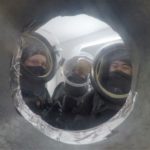
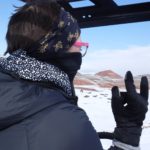
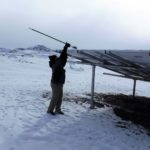
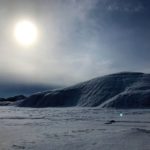
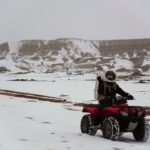
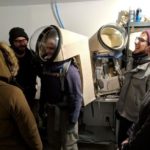
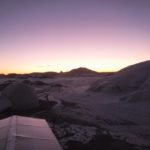

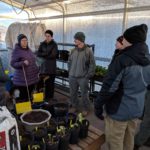
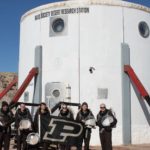
You must be logged in to post a comment.